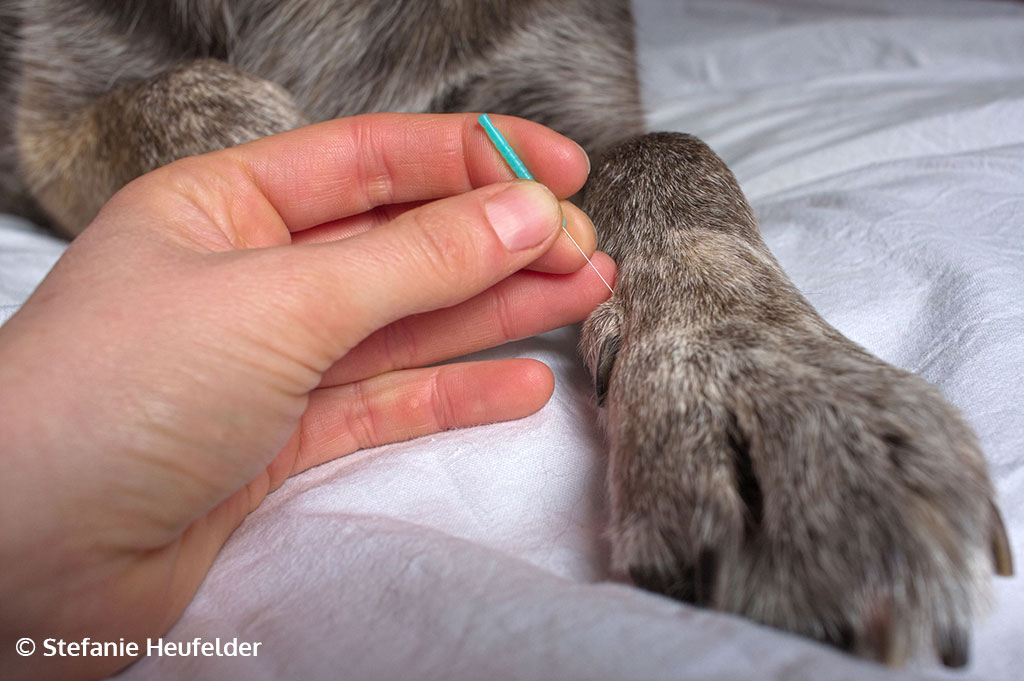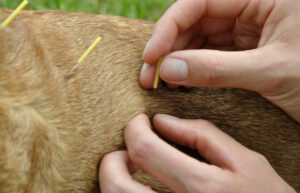
Shana Buchanan, DVM, MBA
Certified Veterinary Acupuncturist
I was introduced to Traditional Chinese Veterinary Medicine (TCVM) in 2001 during my post-graduate internship in Albuquerque, New Mexico. I had been working with a surgeon, Dr. Patricelli, helping her with a few cases. I had not been convinced of the value of TCVM at the time, but one case changed my view: Snuggles. Snuggles was a middle-aged Cocker Spaniel. Just like any Cocker, she wanted to be the center of love and affection. When called, Snuggles would turn her head by moving her entire body instead of using her neck. In fact, Snuggles was unable to turn her head in any direction. Diagnostics did not reveal any skeletal problems or internal issues. So, Dr. P and I began acupuncture treatments to help her.
After a few weeks of acupuncture treatments, Snuggles walked into the clinic almost dancing. She was using her neck. She could turn her head in all directions when called and whenever she wanted. That experience convinced me about TCVM’s value. I decided to pursue it professionally so that I could incorporate it into my everyday practice to help other animals.
Chinese Medicine is a fascinating and challenging field. The following basic overview covers the theories behind it. My I hope is that you will be as interested and inspired by the topic and what it can do for your pets as I am. If you have any questions after reading it, please, feel free to contact me!
TCVM is an ancient practice that has been used to treat animals in China for thousands of years. It was developed through trial and error to understand domesticated animal diseases. Similar to Conventional Western Veterinary Medicine, TCVM has evolved from ancient times, incorporating new information into the practice through the generations. Chinese Medicine, or Eastern Medicine, believes in balanced energy. Because animal bodies are integrated, energetic structures, TCVM practitioners recognize that an energetic imbalance or disturbance of energy flow in the body will create disease processes throughout the entire organism.
Once a disease pattern is identified, TCVM can restore the balance and health of your pet by helping its body regulate itself. Diagnostic tests of TCVM include pulse palpation, tongue evaluation, specific acupuncture point palpation, and history. There are five theories behind TCVM: Yin and Yang, Qi, Meridians, Zang-Fu Organs, and Five Elements.
Yin and Yang
Yin and Yang make up the Tai diagram, symbolizing harmony in the universe. The circle is the universe, divided equally into Yin (black and female) and Yang (white and male). They are continuously merging since a small circle of Yin is within Yang and vice versa. The Yin descends to nourish Yang, and Yang rises to support Yin. Yin and Yang compose and divide all things, yet they cycle unceasingly in the state of eternal transformation.
Qi
The Qi is the force or energy that controls the harmony in any living body. Qi has been referred to as the vital force or life energy that activates and maintains the life process. Most of the Qi can be replenished from proper nutrition, regular exercise, and a good environment. Certain types of Qi cannot be replenished since they are only formed during conception. TCVM manipulates and regulates Qi flow through the Meridian channels.
Meridians
The Meridians are pathways by which Qi and Blood circulate throughout the body. The pathways are not physically visible. However, they unify all parts of the organism, connecting the internal organs with the external body, thus maintaining harmony and equilibrium. Along each meridian, there are special points called acupuncture points. These specific points are used as acupuncture diagnostic points and for treatments for diseases.
Zang-Fu Organs
The Zang-Fu Organs are the internal organs and they are either Yin or Yang. An animal’s health depends upon the function of these organs. The Fu, or Yang, organs are the hollow organs of the body. Fu organs function to absorb nutrients and eliminate waste products. The Fu organs are the stomach, small intestines, large intestine, gall bladder, bladder, and triple burner (no Western medicine equivalent). The Zang, or Yin, organs are solid organs of the body. Zang organs process the absorbed nutritive substances and store the metabolic products. The Zang organs are the liver, spleen, kidney, heart, lung, and pericardium. Each of the Zang-Fu organs is represented by the Meridian system on the external portion of the body.
Five Elements
The five elements involved in TCVM are the elements of the natural world. The elements are Metal, Water, Wood, Fire, and Earth. The Zang-Fu organs are categorized by these elements, describing their nature and the inter-relationship between the body and the natural world. The five-element theory helps TCVM veterinarians in the clinical diagnosis of disease and disease treatments.
TCVM veterinarians help regulate the balance of the body by influencing the Yin and Yang, the Qi, the Meridians, and the Zang-Fu organs of the body in a series of steps.
- Acupuncture on a weekly basis for 6-8 weeks, then gradually decreasing the frequency to the most effective level.
- Herb therapy integrated into treatment can additionally help regulate your pet’s body balance. Herbs should be given in combination with acupuncture treatments and not alone and should only be prescribed by a veterinarian.
- Foods that contain certain properties can help your pet heal and prevent diseases. However, food therapy for sick pets should be explored with caution because you need to have the proper education and training.
Trained TCVM veterinarians should be your source to perform acupuncture treatments and prescribe herbal and food therapies for your pet. All animals can benefit from TCVM treatments, and an integrative approach. Just as it was for Snuggles, incorporating Western and Eastern Medicine to care for your pets will give them the maximum health benefit.
To locate a Veterinary Acupuncturist near you visit the American Academy of Veterinary Acupuncture at http://www.aava.org/search/custom.asp?id=1530
References
Schoen, A. (2001). Veterinary Acupuncture: Ancient Art to Modern Medicine (2nd ed.). Missouri: Mosby, Inc.
Schwartz, C. (1996). Four Paws Five Directions: A Guide to Chinese Medicine for Cats and Dogs. California: Celestial Arts Publishing.
Xie, H & Preast, V. (2002). Traditional Chinese Veterinary Medicine: Volume 1 Fundamental Principles. Florida: Jing Tang.
Xie, H & Preast V. (2007). Xie’s Veterinary Acupuncture. Iowa: Blackwell Publishing.






